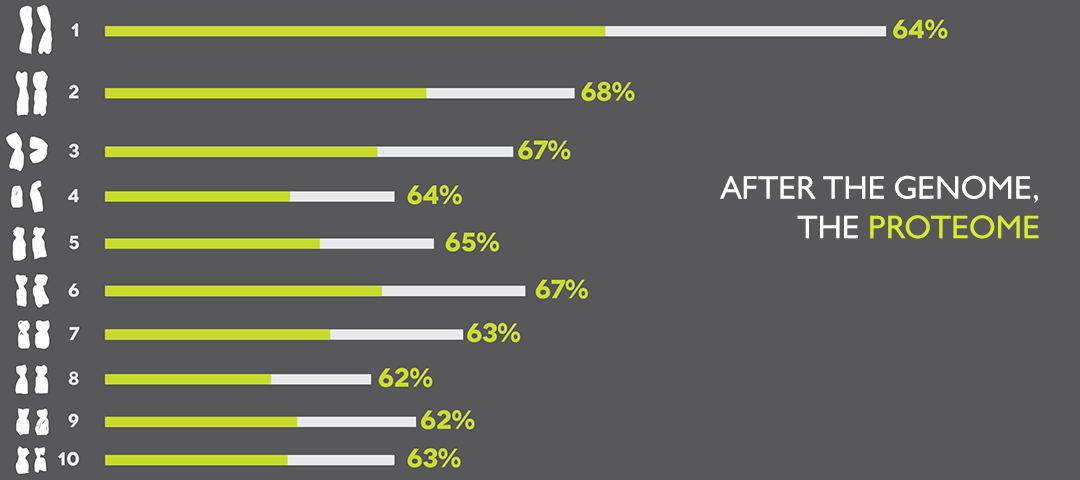- The Human Proteome Project expands on the work of the Human Genome Project.
- ISB is a leader in proteomics and developed PeptideAtlas, a project that has cataloged the proteins observed in thousands of proteomics experiments as an open resource for researchers everywhere.
- In a new report, ISB researchers show that PeptideAtlas now contains proteins from about 62 percent of human genes thought to encode proteins.
By Terry Farrah
Software Engineer, Moritz Group
The Human Genome Project (HGP), declared complete ten years ago, was a defining and important step toward understanding how the human organism works. However, a lot of work remains to make full use of the genome in the practice of medicine. The Human Proteome Project (HPP, www.thehpp.org) is one of several international projects expanding on the HGP.
Proteins are complex molecules that perform a universe of biological processes, and the genome is essentially a set of instructions for making proteins. Some genes appear to encode proteins but those proteins seem to never get made, similar to an architectural plan for a building that is never built. Figuring out which genes actually produce proteins is an initial goal of the HPP, and the PeptideAtlas project at ISB is a key tool in assessing progress toward that goal.
In a paper published online today in the Journal of Proteome Research by Terry Farrah, Eric Deutsch, and co-workers in the Moritz group, as well as prominent collaborators, PeptideAtlas is used to show that there is reliable mass spectrometry-based proteomics evidence for the protein products of 12,644 genes, or 62 percent of all the genes thought to encode proteins. This is an increase of 5 percent over last year. Because proteomics laboratories are now using our list as a guide to target the remaining proteins, this rate of increase is likely to accelerate.
The word proteome refers to the complete set of proteins made by an organism, and proteomics is a set of technologies, primarily using mass spectrometry, for determining which protein molecules exist in a biological sample—a vial of blood, for instance. PeptideAtlas collects the results of hundreds of human proteomics experiments performed around the world and processes them together to produce a single protein list with a very low error rate. If you just combine the protein lists reported for each experiment, you end up with a very high error rate that makes the combined list almost useless. It is PeptideAtlas’s low error rate that allows us to accurately estimate how far the global proteomics community is toward completion of the HPP’s initial goal. This report provides the community the current status of the world’s effort in defining the Human proteome and the list of putative missing proteins remaining to be identified.
Also in today’s publication, we separate our human proteomics data according to its source to create protein lists specific to kidney, urine, and blood plasma. The kidney filters plasma and releases waste into the urine, so these three tissue/biofluid-based proteomes are intimately related. By cataloging the proteins found in each, we assist researchers who are developing biomarker panels for predicting, diagnosing, and monitoring diseases of the kidneys and urogenital tract, similar to the ground-breaking biomarker panel recently announced by our collaborators at Integrated Diagnostics for characterizing pulmonary nodules. Thus, ISB’s PeptideAtlas contributes toward both our basic understanding of biology and the advancement of personalized medicine.



 moritz.isbscience.org/research/isbs-peptideatlas-helps-advance-study-proteins/
moritz.isbscience.org/research/isbs-peptideatlas-helps-advance-study-proteins/